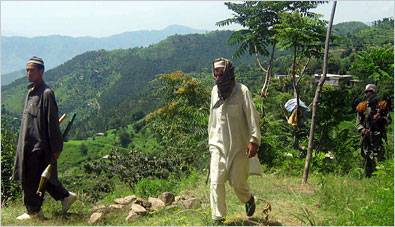
(Photo Credit: Chand Khan, Agence France Presse–Getty Images)
Katherine Tiedemann is a Program Associate at the New America Foundation.
The lead in Jane Perlez and Pir Zubair Shah’s important piece in the New York Times yesterday is troubling: “After a six-month campaign, the Pakistani military is claiming victory over the Taliban in Bajaur, a northern sliver of the tribal areas, saying the militants have suffered heavy losses and have been pushed over the border into Afghanistan.”
It is the latter part that is worrisome; it reflects a lack of recognition on the side of the Pakistani military that simply pushing the militants over the border into Afghanistan is not going to solve Pakistan’s Islamist problem.
Pakistan’s army has been struggling against the Taliban and assorted Islamist militants for a long time now – some 120,000 Pakistani troops are currently on the border (half in the FATA/NWFP), and yet about three quarters of Pakistan’s 63 suicide attacks in 2008 occurred in the tribal areas and the North West Frontier Province, while there were more than 1,000 terrorist attacks in the NWFP alone last year (data courtesy of the Pakistan Institute for Peace Studies).
British foreign secretary David Miliband stated recently what is fast becoming trite conventional wisdom in the Af-Pak morass: that Pakistan’s internal militants present a “mortal threat” to the state of Pakistan.
This is exemplified by the fact that the Pakistani government essentially granted the Taliban sole control over the Swat Valley, allowing the militants to implement Sharia law–an alternate universe’s take on land-for-peace.
I’m skeptical of the efficacy of this approach–12 Taliban militants have already been released into Swat, and while no alleged “prominent” Taliban were among the freed, it is not a good sign that it has been less than one month since the truce was announced and Pakistan’s government is already buckling.
I’m also wary of claims that Bajaur is fully under the control of the Pakistani government and that the Taliban has really been uprooted – one way to tell whether true progress has been made is whether or not the some 300,000 Bajaur refugees and 200,000 Swat valley refugees displaced by the conflict return home. I will be keeping an eye on that in the coming months.
President Obama is on to something with his statement to the Times this weekend that “At the heart of a new Afghanistan policy is a going to be a smarter Pakistan policy. As long as you’ve got safe havens in these border regions that the Pakistan government can’t control or reach, in effective ways, we’re going to continue to see vulnerability on the Afghan side of the border.”
Richard Holbrooke’s appointment as special envoy to Pakistan and Afghanistan is an acknowledgment by the Obama administration that there really is no other way to reach any kind of sustainable political and security equilibrium aside from dealing with Afghanistan and Pakistan as a package deal.
Further highlighting the necessity of an integrated approach to battling militancy in the region is the fact that some 80 to 90% of American supplies to Afghanistan flow through Pakistan, and these supply chains have been the new punching bag of Taliban militants in recent months.
The Pakistani government must understand that merely transplanting the militants from one side of the Durand Line to the other is no way to create a safe and stable region.
— Katherine Tiedemann


6 comments on “Guest Post by Katherine Tiedemann: A PAK-age Deal”